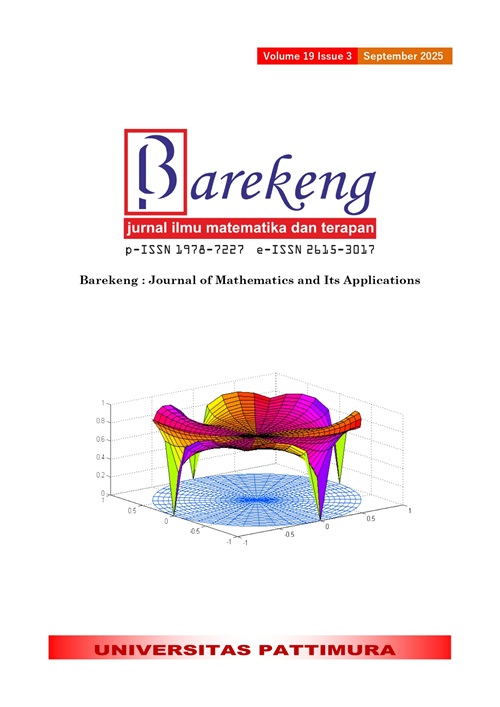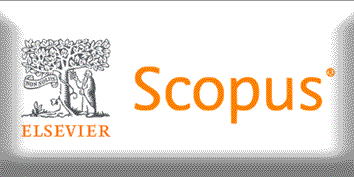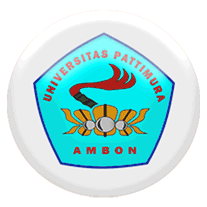COMPARISON OF EXPONENTIALLY WEIGHTED MOVING AVERAGE CONTROL CHART WITH HOMOGENEOUSLY WEIGHTED MOVING AVERAGE CONTROL CHARTS AND ITS APPLICATION
Abstract
The Exponentially Weighted Moving Average (EWMA) control chart is a widely used memory-type control chart known for detecting small shifts in process means. The recently developed Homogeneously Weighted Moving Average (HWMA) control chart modifies the weighting scheme of EWMA, giving more weight to the latest data and distributing smaller weights evenly to past data to further improve sensitivity. This paper compares the performance of EWMA and HWMA control charts on an iron pipe production process dataset. The methodology involves a two-phase analysis: Phase I for establishing in-control process limits (with normality testing, parameter estimation, and determination of optimal smoothing weights) and Phase II for monitoring new data using the established charts. The performance of each chart is evaluated using the Average Run Length (ARL) metric – specifically, the ability to quickly detect small shifts (ARL₁) while maintaining a low false alarm rate (ARL₀). The results indicate that the HWMA chart consistently achieves a smaller ARL₁ than the EWMA chart for small mean shifts without sacrificing in-control ARL, implying higher sensitivity to subtle process changes. Consequently, the HWMA control chart can detect small deviations in the iron pipe length more rapidly than the EWMA chart. These findings align with recent literature and demonstrate practical significance for quality control: the HWMA chart would enable earlier detection of process issues, allowing for quicker corrective actions in manufacturing. We conclude that the HWMA control chart outperforms the EWMA chart in this application, and we recommend its use for processes where small shifts in the mean are of critical concern. Additionally, we suggest further validation through Monte Carlo simulation and comparisons with other control chart methods (such as CUSUM or extended EWMA variants) to reinforce these conclusions for broader contexts.
Downloads
References
E. Prihastono, “PENGENDALIAN PROSES STATISTIK UNTUK MENINGKATKAN PRODUKTIVITAS DAN KUALITAS PADA INDUSTRI,” DinamikaTeknik, vol. 6, no. 2, 2012.
L. V. Hignasari, “TINJAUAN TEORITIS PENGENDALIAN KUALITAS PRODUK HASIL INDUSTRI DENGAN METODE STATISTIK,” Jurnal Ilmiah Vastuwidya, vol. 3, no. 1, pp. 24–29, 2020.
D. C. Montgomery, INTRODUCTION TO STATISTICAL QUALITY CONTROL, 8th ed. John Wiley & Sons, 2020.
S. Sarliani and others, “PENGEMBANGAN BAGAN KENDALI TRIPLE HOMOGENEOUSLY WEIGHTED MOVING AVERAGE DALAM MENINGKATKAN DETEKSI PERGESERAN RATA-RATA PROSES= DEVELOPMENT OF THE TRIPLE HOMOGENEOUSLY WEIGHTED MOVING AVERAGE CONTROL CHART IN ENHANCING DETECTION OF PROCESS MEAN SHIFTS,” Universitas Hasanuddin, 2024.
N. A. Ajadi, O. Asiribo, and G. Dawodu, “Progressive mean exponentially weighted moving average control chart for monitoring the process location,” International Journal of Quality & Reliability Management, vol. 38, no. 8, pp. 1680–1694, 2020.doi: https://doi.org/10.1108/IJQRM-05-2020-0138
M. S. Saccucci and J. M. Lucas, “Average Run Lengths for Exponentially Weighted Moving Average Control Schemes Using the Markov Chain Approach,” Journal of Quality Technology, vol. 22, no. 2, pp. 154–162, 1990, doi: https://doi.org/10.1080/00224065.1990.11979227.
J. S. Hunter, “THE EXPONENTIALLY WEIGHTED MOVING AVERAGE,” Journal of Quality Technology, vol. 18, no. 4, pp. 203–210, 1986, doi: https://doi.org/10.1080/00224065.1986.11979014.
V. Alevizakos, A. Chatterjee, K. Chatterjee, and C. Koukouvinos, “THE EXPONENTIATED EXPONENTIALLY WEIGHTED MOVING AVERAGE CONTROL CHART,” Statistical Papers, vol. 65, no. 6, pp. 3853–3891, 2024, doi: https://doi.org/10.1007/s00362-024-01544-2.
V. V Koshti and A. A. Kalgonda, “A STUDY OF ROBUSTNESS OF THE EXPONENTIALLY WEIGHTED MOVING AVERAGE CONTROL CHART: A SIMULATION APPROACH,” International Journal of Advanced Scientific and technical research, 2 (1), pp. 519–525, 2011.
I. Antono, R. Santoso, and Y. Wilandari, “KOMPUTASI METODE EXPONENTIALLY WEIGHTED MOVING AVERAGE UNTUK PENGENDALIAN KUALITAS PROSES PRODUKSIMENGGUNAKAN GUI MATLAB (STUDI KASUS: PT DJARUM KUDUS SKT BRAK MEGAWON III),” Jurnal Gaussian, vol. 5, no. 4, pp. 673–682, 2016.
N. Nelwati, H. Yozza, and M. Maiyastri, “PETA KENDALI EXPONENTIALLY WEIGHTED MOVING AVERAGE (EWMA) UNTUK JUMLAH WISATAWAN YANG BERKUNJUNG KE SUMATERA BARAT,” Jurnal Matematika UNAND, vol. 4, no. 4, pp. 83–90, 2019.doi: https://doi.org/10.25077/jmu.4.4.83-90.2015
W. Febrina and W. Fitriana, “EXPONENTIAL WEIGHT MOVING AVERAGE (EWMA) CONTROL CHART FOR QUALITY CONTROL OF CRUDE PALM OIL PRODUCT,” International Journal of Management and Business Applied, vol. 1, no. 1, pp. 19–27, 2022.doi: https://doi.org/10.54099/ijmba.v1i1.93
M. Riaz, S. Ahmad, T. Mahmood, and N. Abbas, “ON REASSESSMENT OF THE HWMA CHART FOR PROCESS MONITORING,” Processes, vol. 10, no. 6, p. 1129, 2022.doi: https://doi.org/10.3390/pr10061129
N. Abbas, “HOMOGENEOUSLY WEIGHTED MOVING AVERAGE CONTROL CHART WITH AN APPLICATION IN SUBSTRATE MANUFACTURING PROCESS,” Comput Ind Eng, vol. 120, pp. 460–470, 2018.doi: https://doi.org/10.1016/j.cie.2018.05.009
Z. Rasheed, H. Zhang, S. M. Anwar, and B. Zaman, “HOMOGENEOUSLY MIXED MEMORY CHARTS WITH APPLICATION IN THE SUBSTRATE PRODUCTION PROCESS,” Math Probl Eng, vol. 2021, no. 1, p. 2582210, 2021.doi: https://doi.org/10.1155/2021/2582210
T. Cahyono, “STATISTIK UJI NORMALITAS,” Yayasan Sanitarian Banyumas, Banyumas, Indonesia, 2015.
A. Quraisy, “NORMALITAS DATA MENGGUNAKAN UJI KOLMOGOROV-SMIRNOV DAN SAPHIRO-WILK: STUDI KASUS PENGHASILAN ORANG TUA MAHASISWA PRODI PENDIDIKAN MATEMATIKA UNISMUH MAKASSAR,” J-HEST Journal of Health Education Economics Science and Technology, vol. 3, no. 1, pp. 7–11, 2020.doi: https://doi.org/10.36339/jhest.v3i1.42
D. T. Wijayanti, H. Helmi, and N. Imro’ah, “PERBANDINGAN KINERJA PETA KENDALI CUMULATIVE SUM DAN PETA KENDALI EXPONENTIALLY WEIGHTED MOVING AVERAGE,” Bimaster: Buletin Ilmiah Matematika, Statistika dan Terapannya, vol. 9, no. 4, 2020.
R. M. Pratiwi and W. Wibawati, “FUZZY UNIVARIATE CONTROL CHART UNTUK MONITORING KUALITAS KETEBALAN LEM LABELSTOCK di PT" XYZ",” Jurnal Sains dan Seni ITS, vol. 9, no. 2, p. 487961, 2021.doi: https://doi.org/10.12962/j23373520.v9i2.53549
S. A. Abbasi, S. H. Nassar, M. M. Aldosari, and O. A. Adeoti, “EFFICIENT HOMOGENEOUSLY WEIGHTED DISPERSION CONTROL CHARTS WITH AN APPLICATION TO DISTILLATION PROCESS,” Qual Reliab Eng Int, vol. 37, no. 8, pp. 3221–3241, 2021.doi: https://doi.org/10.1002/qre.2904
M. Hakam, “PERBANDINGAN GRAFIK KENDALI CUSUM (CUMULATIVE SUM) DAN EWMA (EXPONENTIALLY WEIGHTED MOVING AVERAGE) DALAM PENGENDALIAN KUALITAS PRODUKSI PIPA BESI PADA PT. PACIFIC ANGKASA ABADI,” Surabaya: Tugas Akhir-Jurusan Matematika ITS Surabaya, 2017.
F. Marzeta and others, “PENGGUNAAN PETA KENDALI EXTENDED EXPONENTIALLY WEIGHTED MOVING AVERAGE PADA DATA PRODUKSI PIPA BESI PT. PACIFIC ANGKASA ABADI,” Universitas Hasanuddin, 2024.
A. M. Rajab and others, “PENERAPAN BAGAN KENDALI MODIFIED CUMULATIVE SUM DALAM MENDETEKSI PERGESERAN RATA-RATA PADA DATA PRODUKSI PIPA BESI PT. PACIFIC ANGKASA ABADI,” Universitas Hasanuddin, 2023.
Copyright (c) 2025 Erna Tri Herdiani, Mustabsyirah Mustabsyirah

This work is licensed under a Creative Commons Attribution-ShareAlike 4.0 International License.
Authors who publish with this Journal agree to the following terms:
- Author retain copyright and grant the journal right of first publication with the work simultaneously licensed under a creative commons attribution license that allow others to share the work within an acknowledgement of the work’s authorship and initial publication of this journal.
- Authors are able to enter into separate, additional contractual arrangement for the non-exclusive distribution of the journal’s published version of the work (e.g. acknowledgement of its initial publication in this journal).
- Authors are permitted and encouraged to post their work online (e.g. in institutional repositories or on their websites) prior to and during the submission process, as it can lead to productive exchanges, as well as earlier and greater citation of published works.






1.gif)



